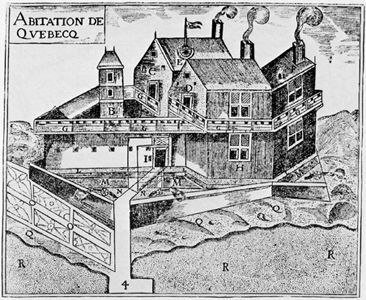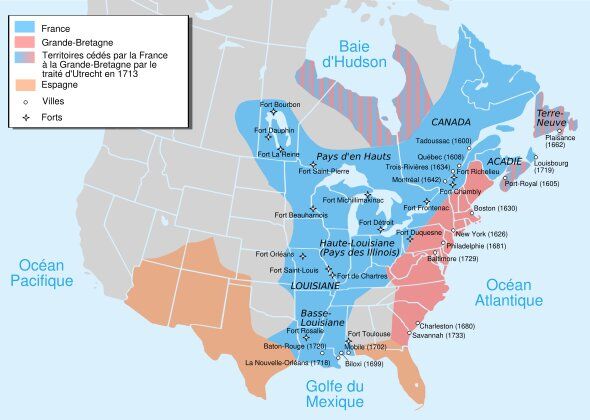The concepts covered in this sheet go beyond those seen in secondary school. It is intended as a supplement for those who are curious to find out more.
France took longer to colonise the new territories. Before showing a desire to populate and control the region, the French were primarily interested in discovering a passage to the Pacific Ocean and the Indies by bypassing the American continent to the north. French colonization in North America lasted some 225 years.
During the first 70 years of French exploration in America, there was no real colonial success story. Indeed, between 1534 and 1608, very few colonists made the journey to the territories of New France.
Given the small number of French colonists in New France, they had little choice but to ally themselves with the Aboriginals if they wanted to survive. From the outset of colonization, the French quickly allied themselves with the Algonquins. This alliance enabled the colonists to survive and adapt to a much harsher climate than they were used to. What's more, the French could learn a new way of life that would be better adapted to the climate, resources and environment. In addition to the benefits of adaptation and lifestyle, the French also benefited economically from their alliance with the Algonquins. They were able to do good business thanks to the fur trade.
However, the alliance between the French and the Algonquins was not all good news. Since the Algonquins were at war with the Iroquois, the Iroquois became enemies of the French. The French colonists therefore took part in a war that had nothing to do with them. The Iroquois also considered the French to be their enemies. This is why the alliance between the British and the Iroquois came about later.
The situation changed somewhat when Samuel de Champlain founded the city of Québec in 1608. In creating the city, Champlain affirmed his motivation to make New France a true French settler colony. However, there was still a shortage of settlers.

Champlain had this ‘abbey’ built to found the city of Quebec.
Later, the Jesuits, a religious group, settled in the colony with the firm intention of evangelizing the Hurons and Iroquois. A few years later, in 1642, the city of Montreal was founded. It became a meeting place for farmers, merchants, Jesuits and coureurs des bois.

Samuel de Champlain
Until 1663, the development of New France was ensured by the fur trading companies. These companies had two missions: to develop the fur trade and to recruit colonists. All the companies concentrated solely on profitable activities and abandoned the recruitment of colonists.
At the time, there were only around 2,500 French people living on the shores between Montreal and Quebec. These settlers occupied only a small part of the territory: only 34 square kilometres were occupied or cleared. In 1663, the colony became a real possession of the French crown. The king of the time, Louis XIV, and his minister Colbert introduced measures to encourage the settlement of New France. They appointed a governor and an intendant.
The intendant sent to New France, Jean Talon, was responsible for administering the day-to-day business of the colony, ensuring the economic diversification of New France and managing the justice system. In addition, a number of measures were taken to increase the number of colonists immigrating to the United States.

Jean Talon
Meanwhile, missionaries and 'coureurs des bois' continued to explore the vast territory of North America.
Throughout the development of the new French territory, colonization was slowed down by the divisions and religious wars of the Renaissance.
The settlers who immigrated to New France all arrived for different reasons and with different motivations: the religious wished to evangelize the Aboriginals, the merchants wanted to make a fortune from the fur trade, the military hoped to rise through the ranks more quickly in colonial territory and many young people saw it as an opportunity to travel, discover the world and work.
At that time, most of the population lived on farmland near the three existing cities: Quebec, Montreal and Trois-Rivières. The establishment of the colonial regime greatly favoured the development of agriculture. In the 18th century, New France had no fewer than 250 seigneuries. Wheat production was already sufficient for export.
While work was concentrated on farming, social life was organised around parishes. Many churches had been built and the parishes organised the social life of Canadians. At the time, religious groups had a great deal of influence over the population. They could even refuse Protestants access to New France. These religious groups did not accept religious dissent at all. Religious congregations such as the Récollets, the Sulpicians, the Jesuits and the Ursulines had a decisive influence on the social and political life of the French colony.
The population has evolved and is now defined as Canadian. In the 18th century, however, the population was only 60,000. Given the vast size of this territory, the population would prove insufficient to defend it. At the time, New France occupied a large part of North America. The territory stretched from the Rockies to the Gulf of St Lawrence, and south to the mouth of the Mississippi. The French population was no match for the power and population density of the English. This was one of the reasons why, in 1760, New France was taken by the British Empire.
